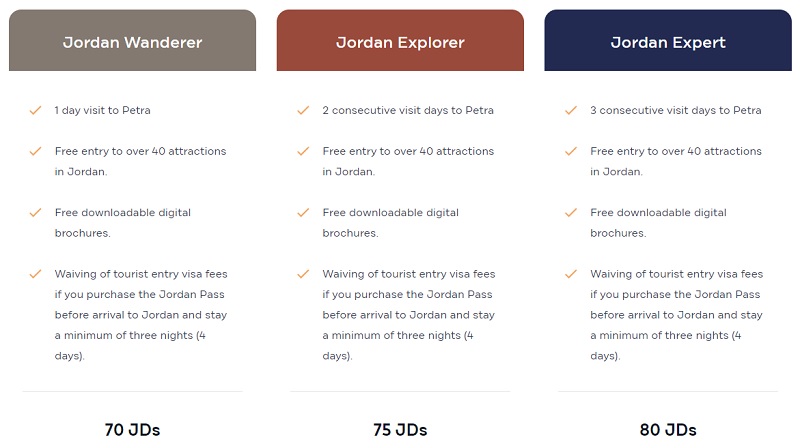Petra: How to Plan Your Visit to Jordan’s Most Famous Sight
This guide explains the best way to plan your visit to Petra in Jordan and takes you on a tour of the entire archaeological site.
A visit to Petra
After a beautiful bus ride from Aqaba — including a stop en route at the Wadi Rum Desert — I arrived in Wadi Musa, the town where you’ll find Jordan’s most famous sight, Petra.
Petra was the ancient capital of the Nabataean Kingdom, flourishing as a thriving trade hub from the 4th century BC until its decline in the 2nd century AD.
Of course, Petra is most renowned for its splendid rock-cut architecture and mysterious temples and tombs, which famously served as the backdrop for Steven Spielberg’s film Indiana Jones and the Last Crusade.
I previously visited Petra during my university backpacking days, on a long overland journey from Istanbul to Jerusalem via Syria and Jordan.
Although I’ve since explored many other remarkable archaeological sites around the world — from Abu Simbel and Karnak in Egypt to Ephesus in Turkey — few are as impressive as Petra.
There’s just something special about Petra — whether it’s the spectacular setting, the mysterious history, or the great hikes to nearby sights — so I gladly revisited it on this Jordan trip.

How many days you need to visit Petra?
Although you can see Petra’s main sights in a single day, it’s a vast archaeological site with many fascinating ruins and scenic viewpoints, so you really need at least two days to explore it properly and to really do it justice.
Just to put the dimensions into perspective, the Petra Archaeological Park — a protected area managed by Jordan’s Ministry of Tourism and Antiquities — covers a massive 264 square kilometres!
I spent two days in Petra, with my itinerary on day 1 featuring a visit to the Treasury and nearby sights like the Royal Tombs, followed by a hike to Ad-Dayr (the Monastery), while day 2 involved hiking the Al-Khubtha Trail for stunning views from the clifftop above the Treasury, as well as hiking to the High Place of Sacrifice and the Garden Temple.
Further down this guide, I’ll provide a detailed account of my two-day visit to Petra, including the hikes, along with plenty of information and photos of all the historic sights.

How to get to Petra
Apart from driving a rental car, the easiest way to get to Petra is by bus from Amman, Wadi Rum, or Aqaba.
JETT, short for Jordan Express Tourist Transport, is the largest and most well-established bus company in Jordan, operating services across the country since 1964.
In addition to driving yourself or taking a JETT bus, another option is a shared or private taxi, which can be surprisingly affordable in Jordan, especially for small groups.
Although buying a JETT bus ticket online might seem like the easiest option, many foreign tourists report issues with processing payments due to restrictions on foreign transactions on the JETT website.
If that’s the case, try using a VPN set to a Jordanian server, or buy your bus ticket online or in person once you arrive in Jordan.
In case you do want to book your JETT bus ticket in advance to ensure a seat, you can also use the reliable online booking platform 12Go, which offers both bus tickets and private taxi bookings in Jordan, and accepts all foreign debit and credit cards.
Unless stated otherwise, all buses – including the JETT bus – drop off and pick up passengers at the main bus parking lot next to the Petra Museum.

Petra tickets and entry price
There are two types of tickets for foreign visitors to Petra, with a cheaper option for those spending at least one night in Jordan, and a more expensive ticket for day trippers visiting the country only for the day, such as travellers coming from across the border in Israel or Egypt.
If you spend at least one night in Jordan, you can get a Petra entry ticket for ‘accommodated visitors’, which can be bought for one day (50 Jordanian dinar, €60), two consecutive days (55 JD, €68.20), or three consecutive days (60 JD, €74.40).
Tickets for ‘non-accommodated visitors’ – those who spend only a single day in Petra and arrive and leave Jordan on the same day – currently cost 90 JD (€111.60).
If you visit Petra on your first day of arrival in Jordan but spend the night in or around Wadi Musa, you’ll be charged the 90 JD fee for non-accommodated visitors, though you can receive a 40 JD refund from the ticket office the next day, effectively paying only 50 JD.
Children under 12 can enter Petra for free, while reduced one-day entry tickets are available for Jordanian passport holders (1 JD, €1.25), foreign residents living in Jordan and holding a valid residence permit (10 JD, €12.40), and nationals from other Arab countries (30 JD, €37.20).
Tickets can be purchased at the ticket booths inside the Petra Visitor Center, with payment accepted in cash (Jordanian dinar or US dollars) or by card.
You must show your passport at the Petra ticket office to buy entry tickets, so don’t forget to bring it with you.
At the Visitor Center, you can also arrange any extra service you may require, such as transport across Petra by electric golf car, licenced guides, or tickets to Petra by Night.
Petra is open daily from 06:30 to 17:00 during the winter season (2nd October to 1st March) and from 06:00 to 18:00 during the summer season (2nd March to 1st October).
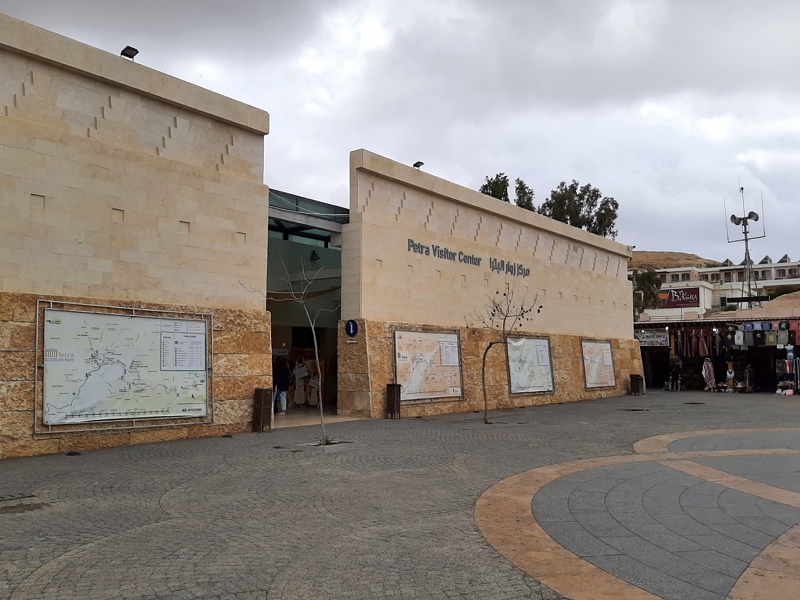

Save money on your Petra visit with the Jordan Pass
For many foreign travellers, buying a Jordan Pass online in advance can be highly advantageous, as it waives the Jordanian tourist visa fee and grants free entry to sights, including Petra.
There are three different categories of the Jordan Pass, with the main difference being the number of days you wish to visit Petra.
– Wanderer Pass, which costs 70 JOD (€89) and includes a 1-day visit to Petra.
– Explorer Pass, which costs 75 JOD (€96) and includes a visit to Petra on 2 consecutive days.
– Expert Pass, which costs 80 JOD (€102) and includes a visit to Petra on 3 consecutive days.
Entering Petra
After you’ve got your entry ticket, you can proceed to the entrance barriers a bit further down the path, just past the Petra Guest House Hotel.
Once you’re through the entrance gate, it’s a 2-kilometre-long, slightly downhill walk to reach the Treasury, the beating heart and most iconic sight of Petra.
On your way to the Treasury, you’ll pass through a narrow gorge called the Siq, a spectacular sight in its own right.
If you’re disabled, have mobility issues, or are simply in a hurry, you can take an electric golf car (also known as a club car) from the Petra Visitor Center to the Treasury and some nearby sights.
This service can be arranged on the spot at the Petra Visitor Center and costs 15 JD (€18.60) per person for a one-way trip to the Treasury, or 25 JD (€31) for a return journey.
Children under 3 travel free if seated on your lap, with each vehicle accommodating a maximum of five people.
This golf car service cannot be pre-booked, so be cautious of providers claiming otherwise, as they will charge a hefty premium for essentially the same service.
However, unless you have serious mobility issues, it’s highly recommended to walk to the Treasury, as you’ll not only gain a better appreciation of Petra’s unique setting and the beauty of the Siq, but also have the opportunity to stop at several sights along the way at your own leisure.
Even before reaching the entrance to the gorge, you’ll already pass a couple of rock-carved tombs and mysterious Djinn blocks, named after the Arabic word for spirit.
The Djinn blocks were carved out of the rock by the Nabataeans in the 1st century AD, although their function and purpose — whether they were simply unfinished tombs or held religious significance — remains unclear.

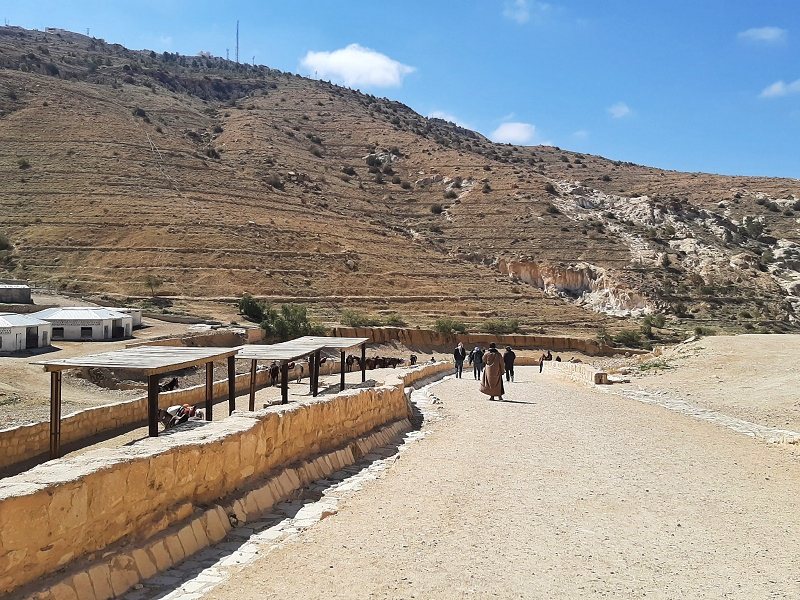

A walk through the Siq
The final 1.2 kilometres of the 2-kilometre walk from the Petra entrance gate to the Treasury takes you through the Siq, an absolutely stunning narrow natural gorge.
Formed over hundreds of thousands of years, the gorge was gradually carved through the sandstone mountains by water and tectonic forces, creating a natural pathway through the rock.
The ancient Nabataeans who inhabited Petra built dams and a tunnel through the mountains to divert most of the seasonal rainwater away from the gorge, shielding them from most of the flash floods to which this desert region is prone.
However, it is not uncommon for an unusually heavy rainstorm – most often in winter or early spring – to flood the canyon floor of the Siq, turning it into a raging river.
In the event of a major rainstorm, the authorities will therefore close the Siq, or even evacuate visitors from Petra, to protect them from the dangers of a sudden flash flood.
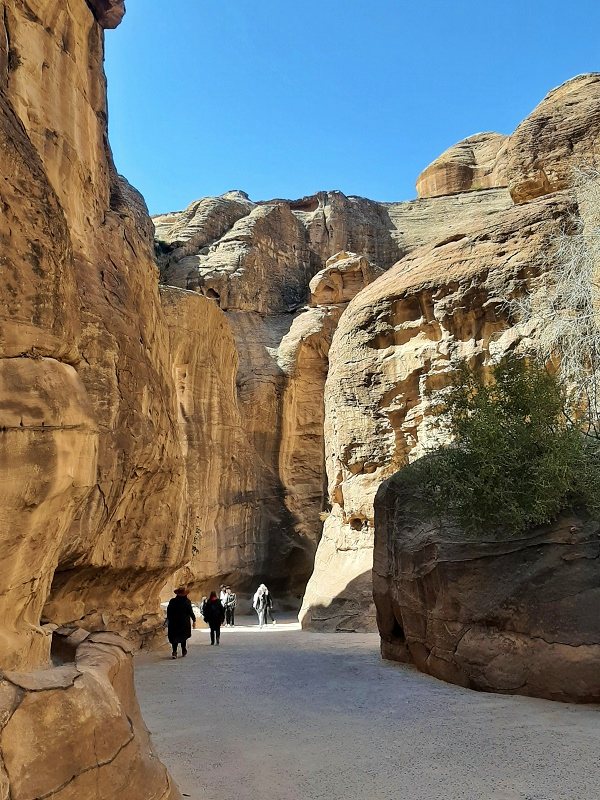


Canyon colours
Luckily, it was a beautiful, sunny winter day when I walked through the Siq, providing the perfect conditions to admire the mighty cliffs and rock formations of the gorge.
Many people rush through the Siq on their way to the main sights of Petra, such as the Treasury, but that’s a mistake, as the Siq is a remarkable sight in its own right.
Especially in the early morning, but also towards late afternoon or early evening, the sunlight casts warm red hues on the sandstone rocks of the Siq, making this the best time of day to visit this part of Petra.
It’s quite remarkable how the sandstone cliffs display their usual yellow, grey, or brownish tones in the middle of the day when the sun is at its highest, or when viewed from the wrong angle, yet with just a few more steps to a different vantage point at the right time of day, the gorge suddenly bursts into brilliant red hues.




Arrival at the Treasury
What’s best about the Siq is that this narrow gorge opens up to the Treasury at its end, making it one of the most dramatic entrances to any archaeological site in the world.
Even though you know what awaits at the end of the Siq, nothing truly prepares you for the moment the Treasury suddenly appears as you make the final turn out of the gorge.
Although it was my second visit to Petra and I had seen it with my own eyes before, it was still an absolutely magical moment to step out of the Siq and find myself standing in front of the Treasury.


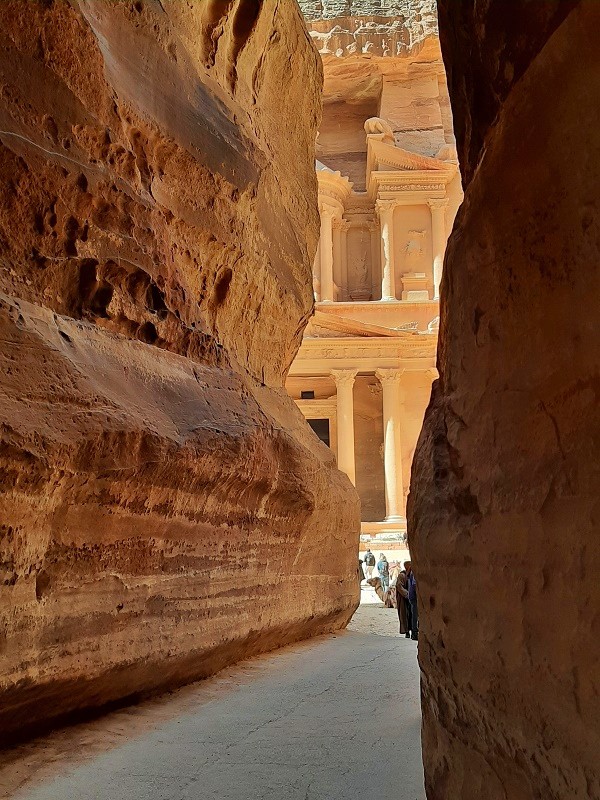
The Treasury
The Treasury is by far the most iconic sight in all of Petra, and its image has come to represent not only the entire archaeological site, but also features prominently on holiday brochures and guide books for Jordan.
Known in Arabic as Al-Khazna, the impressive Hellenistic façade of the Treasury stands 39.5 metres (130 feet) tall and was likely built during the reign of Nabataean King Aretas IV (9 BC–40 AD), although some archaeologists believe it may have been constructed a few decades earlier under one of his predecessors.
The exact function of the Treasury is unknown, although it was likely used as a mausoleum for the Nabataean kings or as a funerary temple.
The name ‘Treasury’ is therefore a bit of a misnomer, derived from a much later legend among the local Bedouin tribes that an Egyptian Pharaoh used the urn at the top of the façade to hide a treasure — something that is actually impossible, as it is a solid piece of rock.
It isn’t possible for visitors to enter the Treasury in Petra, as this is prohibited by local authorities, with guards ensuring that no tourist goes inside.
This is a safety measure due to the potential instability of some inner rooms in the Treasury and the risk of the narrow passageway to the deepest chamber becoming a bottleneck.
Moreover, there is nothing to see inside the Treasury, as the rooms are completely empty, so you aren’t missing out on anything.
The best time to visit the Treasury is in the late afternoon, close to Petra’s closing time, when most tour buses have long left and the number of visitors is at its lowest, allowing you to enjoy the sight with hardly anyone else around.
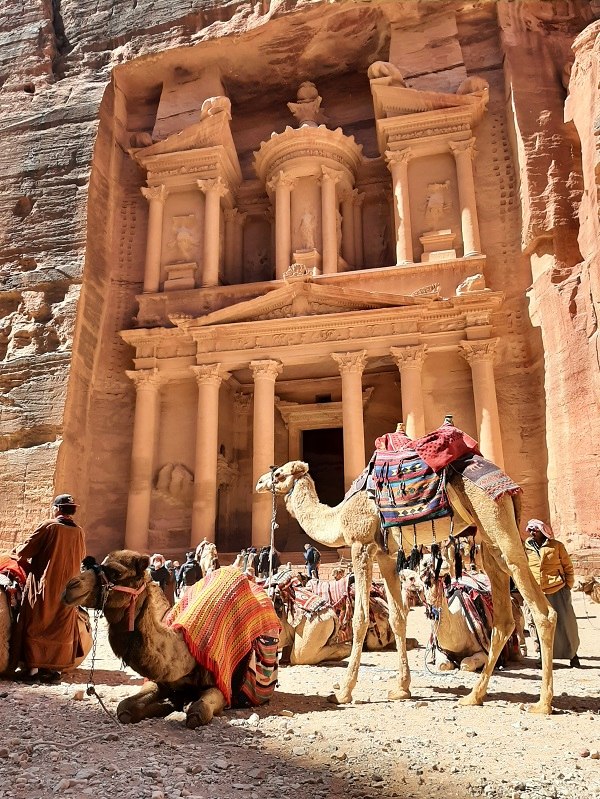
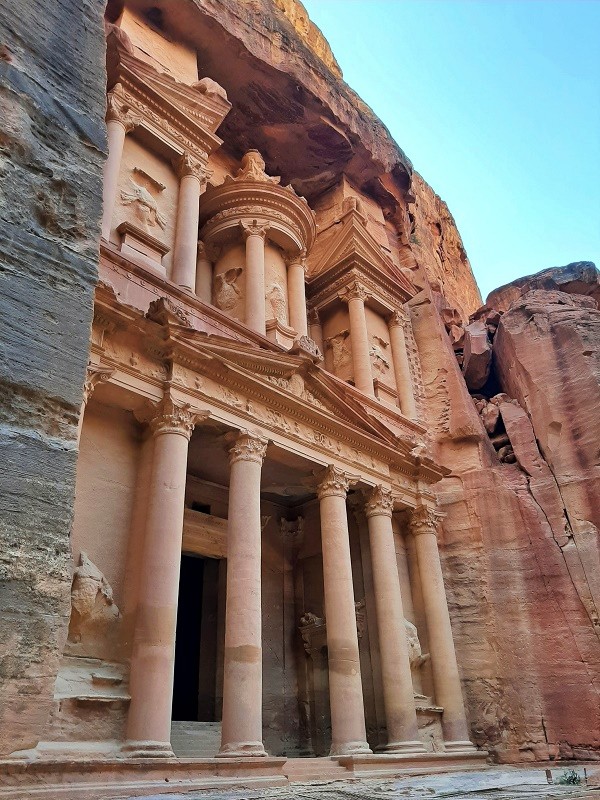
Camels and souvenir stalls
The front of the Treasury is often bustling with hundreds of tourists vying for the perfect picture, along with many camel handlers and their animals.
It doesn’t take much imagination to picture how bustling Petra must have been during the time of the ancient Nabataeans, as even back then this rock-carved city attracted people from all over the world, with trade caravans heading deep into Africa and Asia.
If you want to take a camel ride in Petra, you can speak to one of the camel handlers in front of the Treasury, though be prepared to negotiate hard, as a short ride from the Treasury to Qasr Al Bint should not cost more than 15 JD (€18.60) per camel.
Around the Treasury, as well as at many locations deeper into Petra, you’ll also find many souvenir stalls.
Again, negotiate hard for anything you’re interested in buying, and don’t believe claims that jewellery or gold is authentic and highly valuable, as most items are made from lower-quality materials, such as plated rather than sterling silver, or even imported from wholesalers in China.
Some of the souvenir stalls around Petra also function as shops where you can buy items such as bottled water, cans of soda, and snacks.
Indeed, some of these souvenir stalls also have proper seating like in a café and offer freshly brewed coffee or tea, which, especially on a colder winter day, can warm you up and give you a much-needed energy boost, with the cardamom coffee being especially recommended.

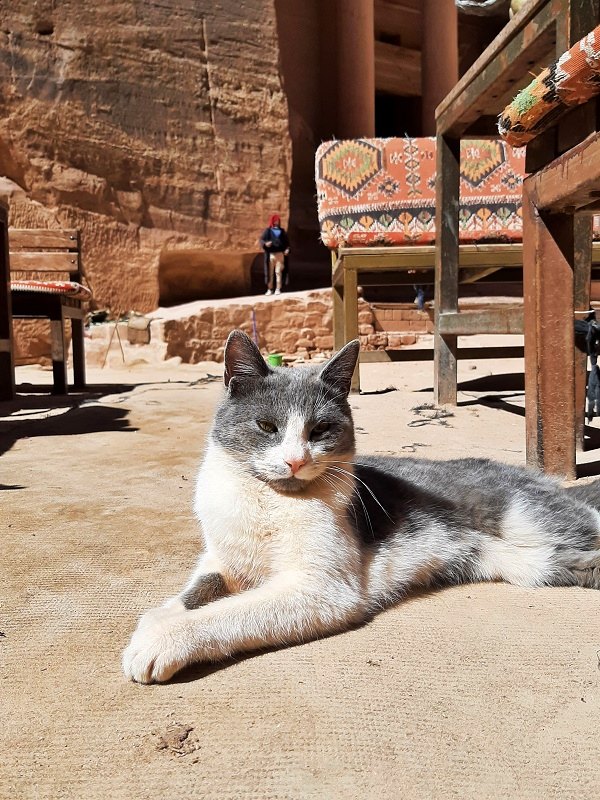

Street of Façades
From the Treasury, the gorge and the main path through Petra widens into what is known as the Street of Façades or the Outer Siq.
The architecture of the tombs differs as well, as unlike the Hellenistic façade of the Treasury, these have a distinct Assyrian style, showing that the Nabataeans were influenced by many different cultures.
You’ll find magnificent tombs and houses carved into the rock on both sides, with the dried-up riverbed running through the middle of the street.







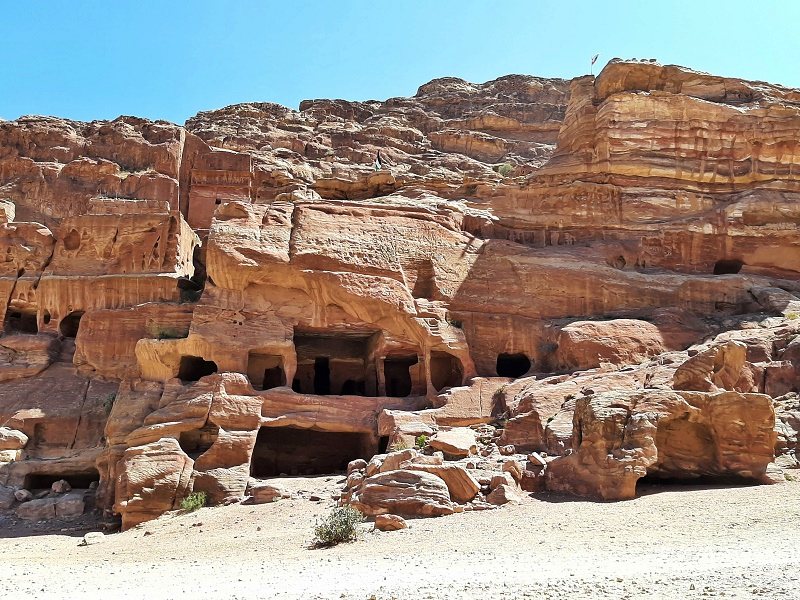

Petra theatre
Towards the end of the Street of Façades, you’ll come across a spectacular theatre on your left-hand side.
The theatre was originally carved out of the rocks by the Nabataeans, but after the mighty Roman Empire conquered Petra in AD 106, it was enlarged to accommodate between 6,000 and 8,000 spectators, nearly 30% of the historic population of the city.
The outlines of the entrances through which the performers entered the theatre, along with the remnants of the Roman-built stage wall, can still be seen.
Of all the ancient theatres, the one at Petra surely ranks among the most spectacular, as it blends seamlessly between the cliffside tombs.

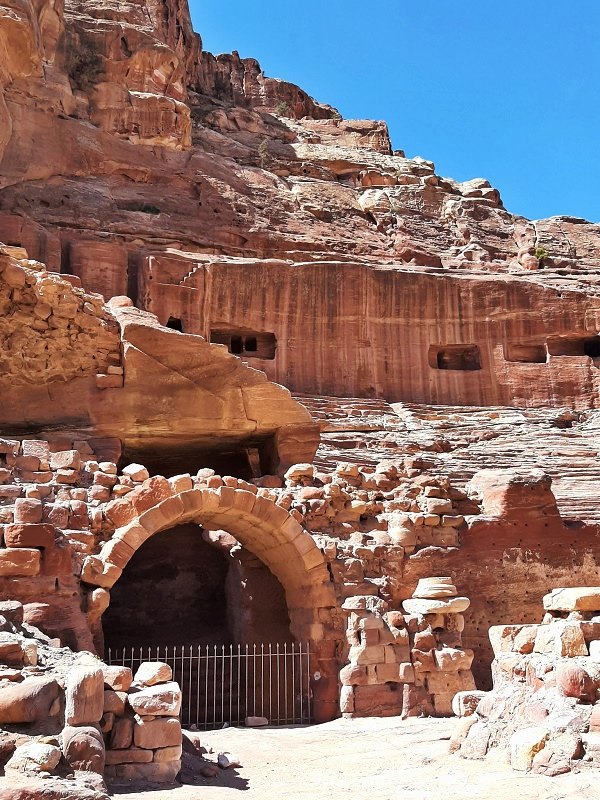

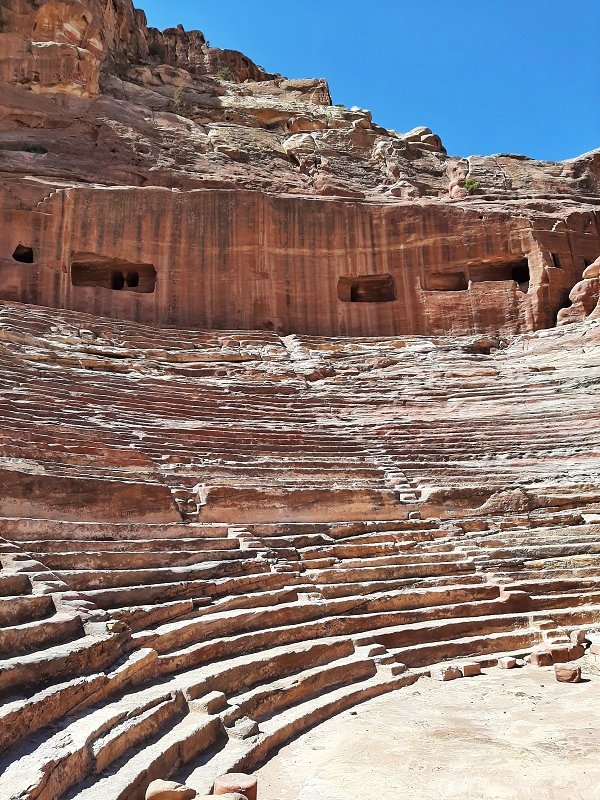
Royal Tombs
As you continue along the Street of Façades, you’ll see the Royal Tombs of Petra high up in the rocks to your right, towards the east.
A short uphill climb along steps lined with souvenir stalls leads you to the Royal Tombs, which are a must-visit not only for their stunning façades but also for the fabulous views across Petra towards the west.
From the Royal Tombs, you can see the gorge below widening into a broad valley, with craggy mountains providing a dramatic backdrop.
The Royal Tombs — of which there are four — are so named because they rank among the most richly decorated burial places in all of Petra, intended for the upper echelons of Nabataean high society.
The Royal Tombs of Petra are the Urn Tomb, Silk Tomb, Corinthian Tomb, and Palace Tomb, each named after elements of their design — in the case of the Urn Tomb, a funerary urn placed on the pediment above the façade, and for the Corinthian Tomb, the Greek Corinthian capitals on its columns.
Being the largest and most elaborate of the four, the Palace Tomb is aptly named, while the Silk Tomb, the smallest of the Royal Tombs, owes its name to the fine natural shades of pink, yellow, and white sandstone on its façade.

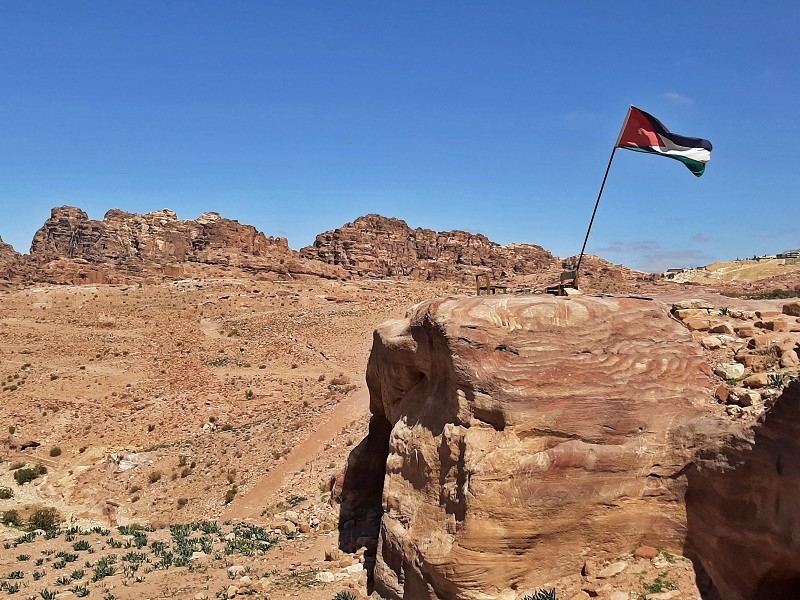


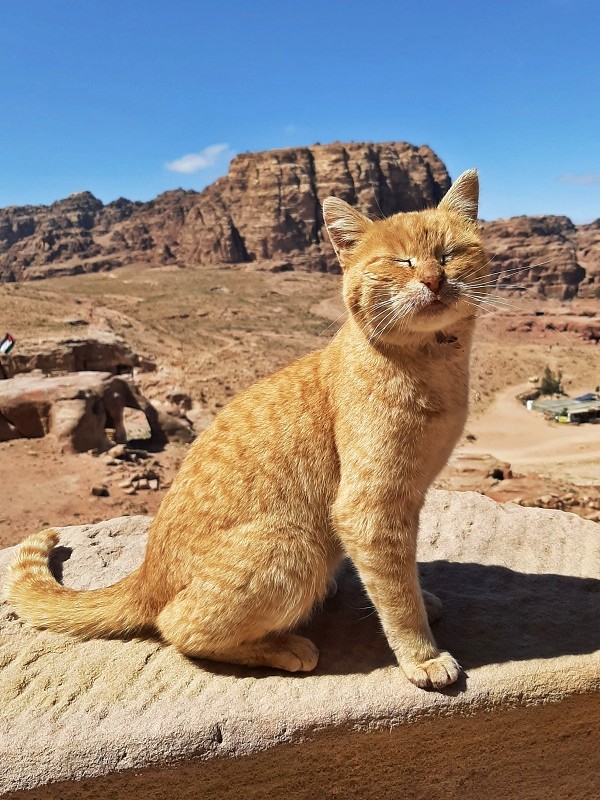



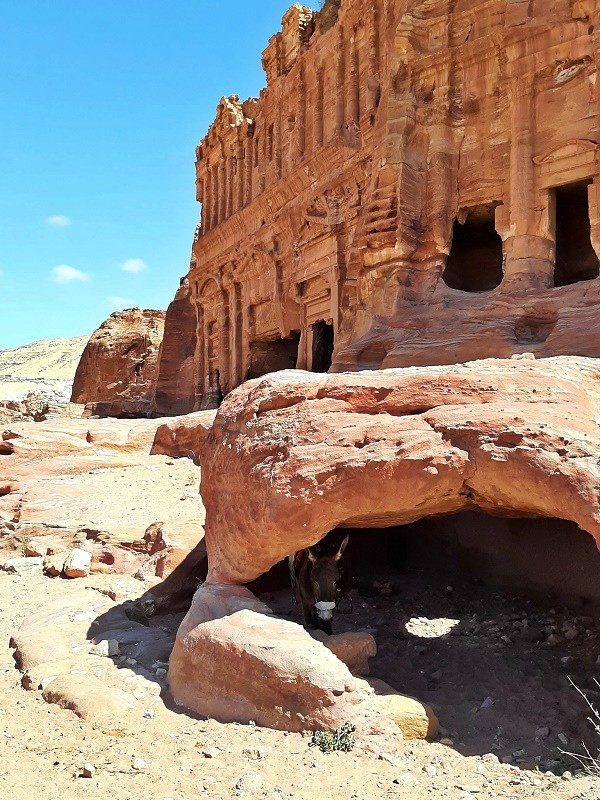
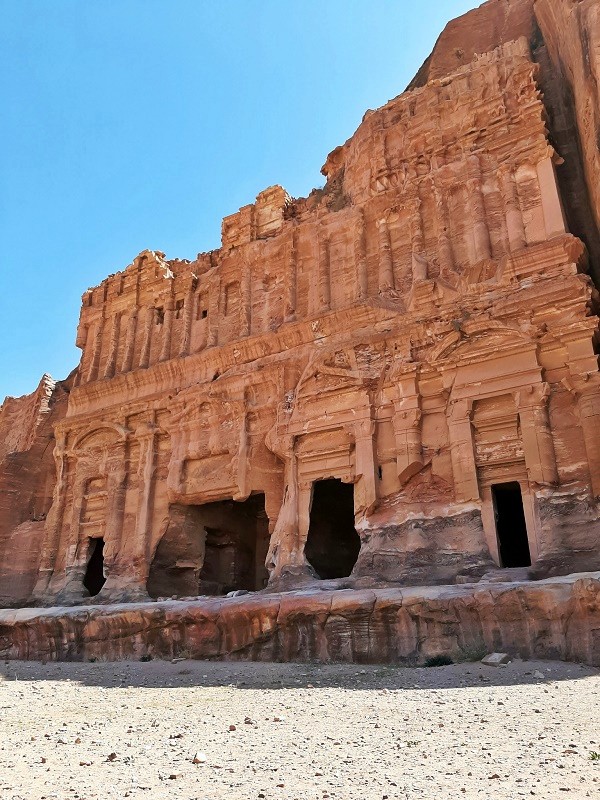
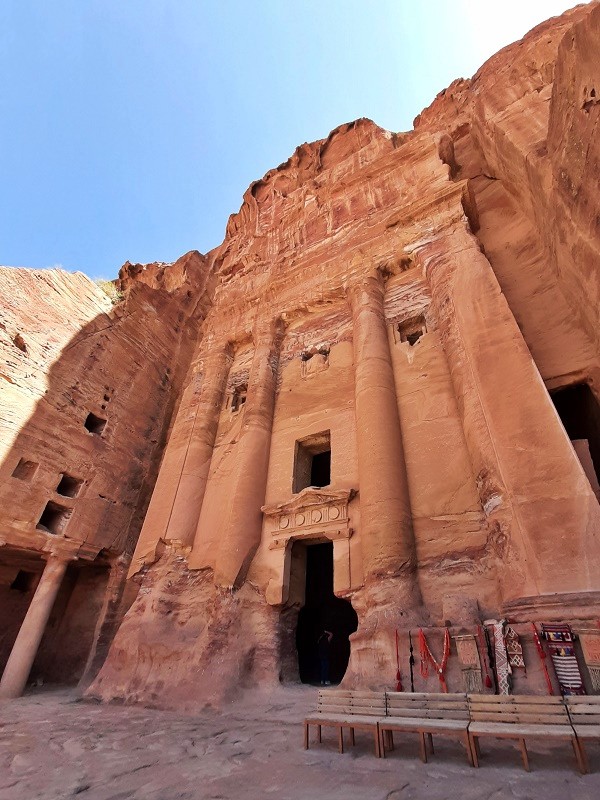



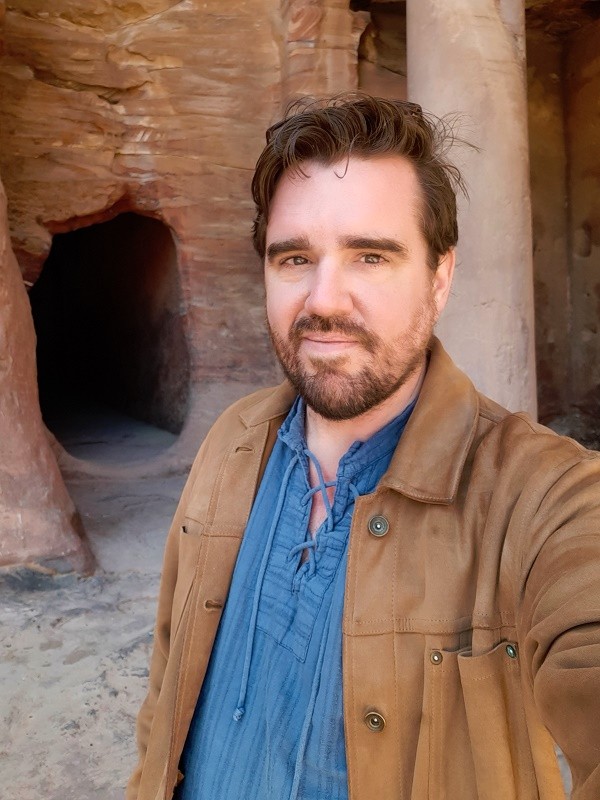
Nymphaeum
As you descend from the Royal Tombs and continue past Petra’s main sights, you’ll eventually arrive at the point where the Street of Façades becomes the Colonnaded Street.
This spot, marked by a large wild pistachio tree estimated to be around 450 years old, is also where the ruins of Petra’s Nymphaeum are found.
The Nymphaeum, constructed in the 2nd century AD and named after the nymphs of classical mythology, served as a public drinking fountain in Petra, supplied with water channelled from the Siq.
Thanks to its central location, flowing water, and ample shade, the Nymphaeum was once a popular meeting place for the people of Petra.
Around the fountain once stood a grand structure, with six columns decorating its façade and a freestanding wall with porticos, although only the stone foundations remain today.
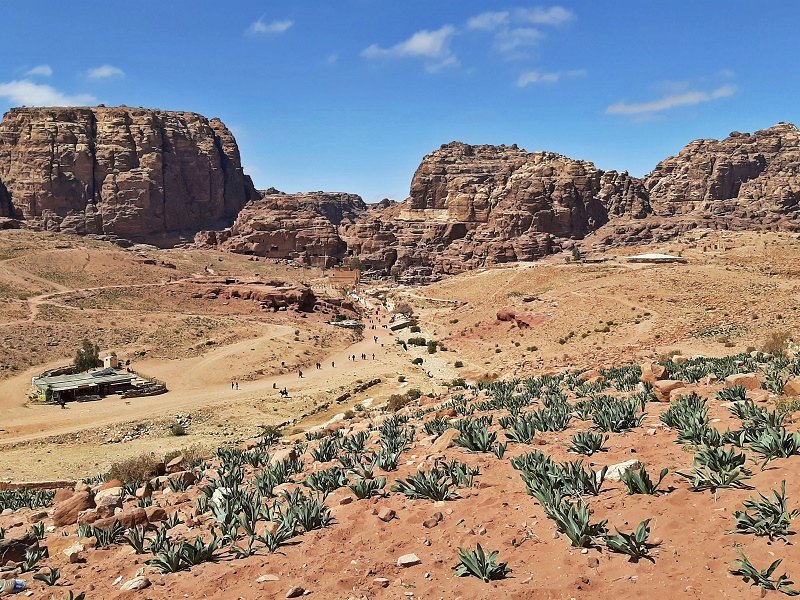

Colonnaded Street
The Colonnaded Street, named for the columns that line this thoroughfare, was once one of the most important streets in the heart of Petra.
Colonnaded Street was once the commercial heart of the ancient city of Petra, with shops and markets lining both sides, trading precious goods brought by caravans from Africa, the Middle East, and India.
Among these goods were textiles and spices from India, frankincense and myrrh from the southern part of the Arabian Peninsula, and ivory from Africa.
The original Nabataean road, which predates Colonnaded Street, was once winding, following the course of the river through Petra, but the Romans later straightened and paved it in the 1st century AD, placing marble columns along the route and building elegant porticoes for the shops.
Sadly, little of this remains due to damage over centuries from earthquakes and flash floods, although with a bit of imagination, you can still get a good sense of how important this road once was.
At the end of Colonnaded Street stands the Temenos Gate, built during the reign of Roman Emperor Trajan in the 2nd century AD.
Temenos refers to the sacred courtyard in front of a temple, where worshippers could offer prayers or make offerings, with the Temenos Gate likely serving as the grand entrance to the Qasr al-Bint Temple.
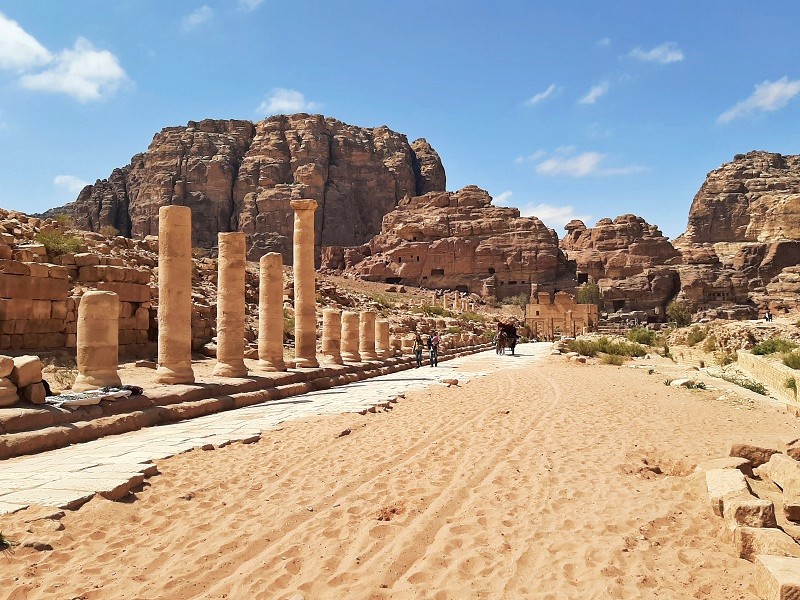

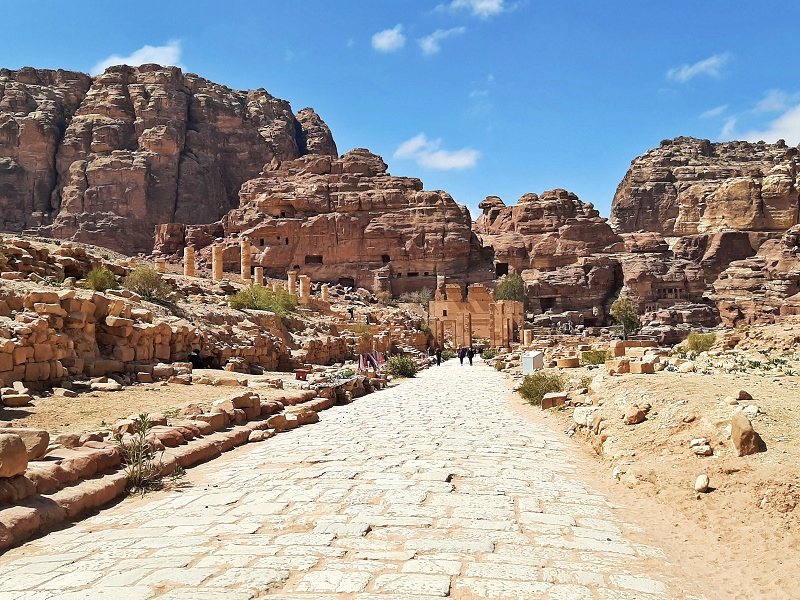

Great Temple
Along Colonnaded Street you will find three of Petra’s main temples, of which the Great Temple is by far the largest.
The Great Temple, built by the Nabataeans in the 1st century BC, once featured an enclosure measuring 40 by 28 metres, with the temple itself standing 18 metres high.
However, shortly after its inauguration, the temple was badly damaged in an earthquake, though it remained in use for many centuries, until the late Byzantine period.
Not much remains of the Great Temple today, although you can still admire the monumental propylaeum (entrance) and stairways, the colonnaded courtyard, and the lower and upper precincts.
Although named the Great Temple, this building likely did not serve a religious function, as archaeologists believe it probably had an important civil role, such as a royal audience or meeting hall.
They base this on excavations that revealed features atypical for a religious building, such as an open-air theatre with semi-circular seating, a workshop, and baths, as well as the Great Temple’s location in Petra’s commercial district, rather than the precinct around the Qasr al-Bint Temple.




Qasr al-Bint
After visiting the Great Temple, I walked through the Temenos Gate to the next Petra sight, the Qasr al-Bint, which was just a short distance further along the road.
Of all the temples in Petra, the Qasr al-Bint is one of the most impressive, as much of this freestanding structure still remains, allowing you to easily grasp its former size and grandeur.
The Arabic name Qasr al-Bint, given to this temple by the local Bedouins, translates to “Castle of the Pharaoh’s Daughter”, although it has no connection to ancient Egypt or Pharaohs.
The Qasr al-Bint, built around 30 BC, was one of the main temples of the Nabataeans, most likely dedicated to their main god Dushara, although it was later repurposed by the Romans for one of their cults.
It is believed by archaeologists that not only the Qasr al-Bint was considered sacred by the Nabataeans, but that the entire precinct around the temple had a religious function.
Unfortunately, the temple was destroyed around the 3rd century AD.
Many of the fine internal features of the temple, including impressive columns, stone reliefs, and marble staircases, have been destroyed or disappeared, although some examples can still be admired in the museum next to the Petra Visitor Center.



Winged Lion Temple
On a hill on the opposite side of the Colonnaded Street, across from the Great Temple, you can find the Winged Lion Temple.
Surprisingly often overlooked by visitors to Petra, possibly because it is not directly on the main road and requires a short climb up the hill, the Winged Lion Temple is well worth a visit as it offers a good overview of the layout of an ancient Nabataean temple.
This temple, named after the winged lions carved onto the capitals that once topped its columns, was likely dedicated to the Nabataean fertility goddess Atargatis, the consort of the main god Dushara.
Thanks to the information signs with detailed maps, the stone walls and foundations of the Winged Lion Temple really come to life, allowing you to clearly identify features such as the inner sanctuary (cella), the altar platform, and even some adjoining workshops.
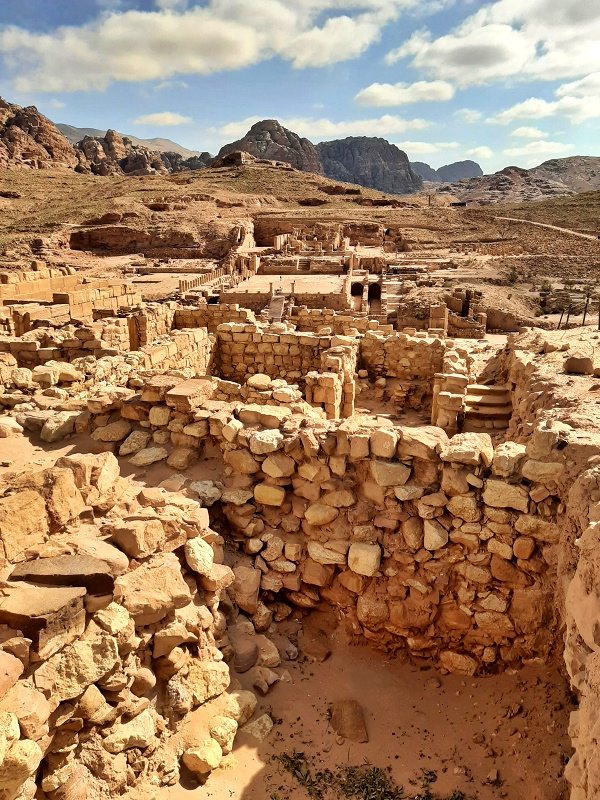
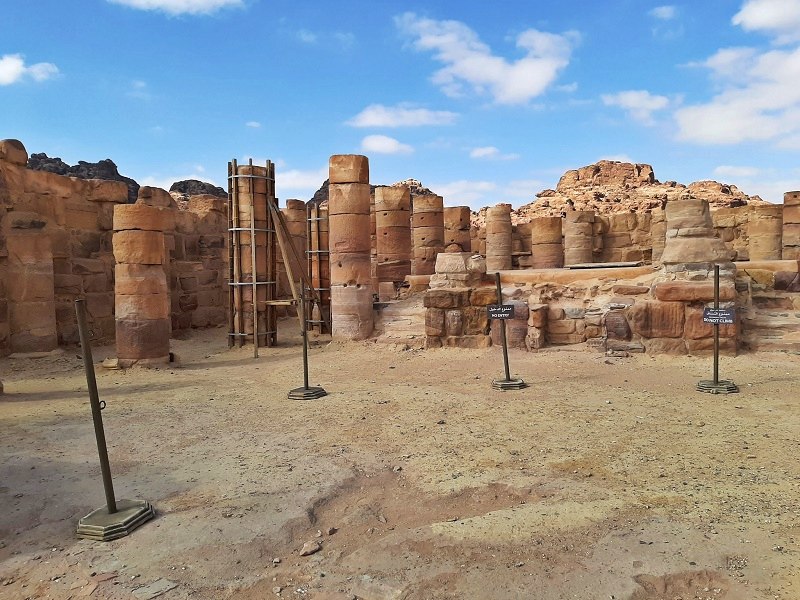


Church Complex of Petra
A bit higher up the hill from the Winged Lion Temple, you can find the Church Complex of Petra, which features the ruins of three Byzantine-era churches: The Ridge Church (also known as the Red Church), Petra Church (also known as the Byzantine Church), and the Blue Chapel.
Of these Petra churches from the 4th and 5th centuries AD, the remnants of the Byzantine Church are the most impressive, as they contain some stunning, well-preserved mosaics.
The remnants of the Blue Chapel, named after the four large blue Egyptian granite columns topped with Nabataean horned capitals, are quite striking as well.
As you climb up the hill from the Winged Lion Temple to the churches, you’ll also be treated to fabulous views over Petra, particularly of the Colonnaded Street and the Great Temple, as well as the Royal Tombs in the far distance.



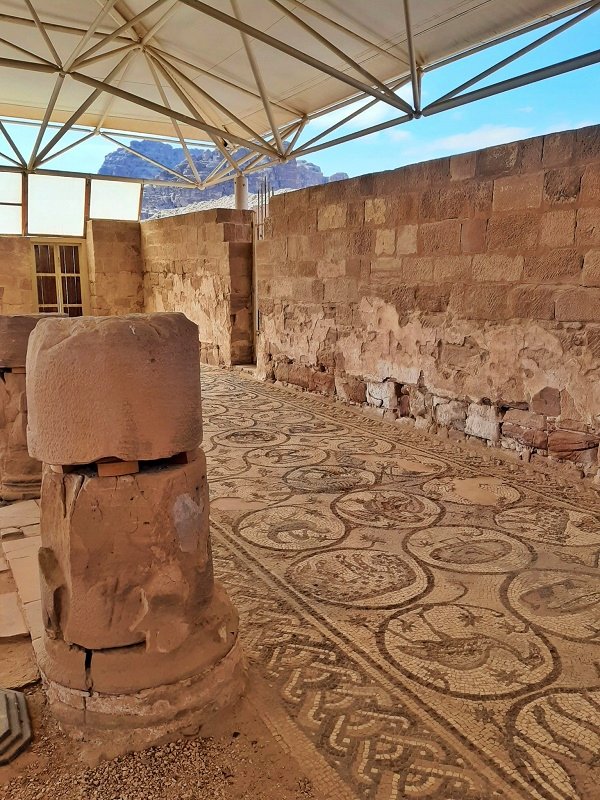

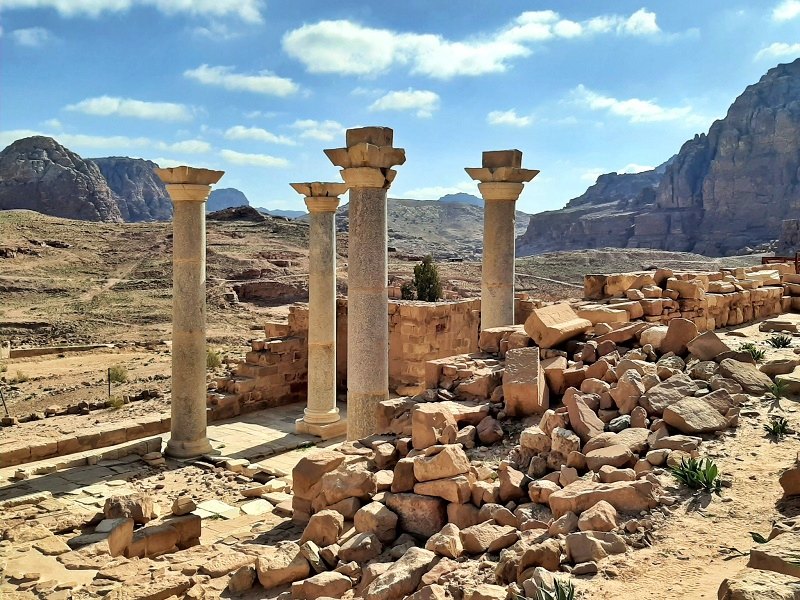
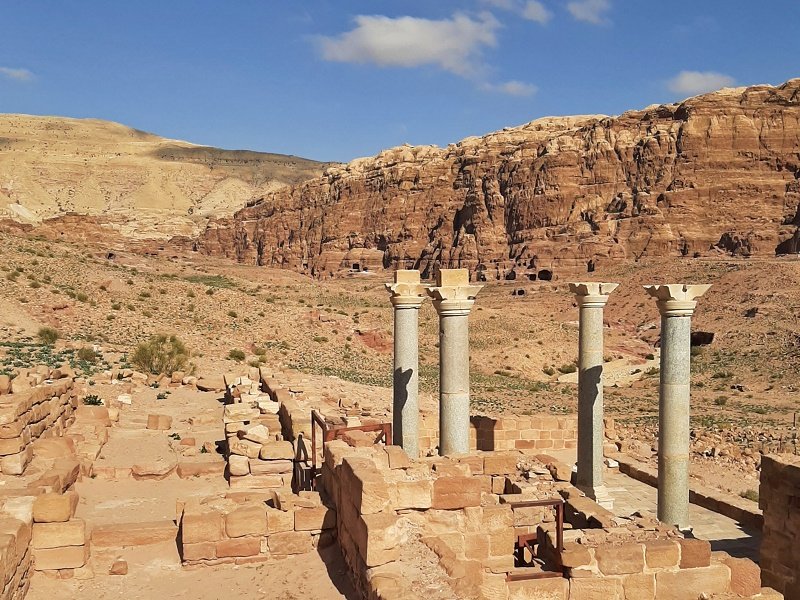
Petra hikes
The sights mentioned above are considered to be in the heart of Petra and can easily be visited within a single day, although there are many other stunning sights that require a bit of a hike from this central area.
To reach those sights, more physical effort is required, as you’ll need to climb sets of steps carved into the rock and hike uphill on paths.
Although you certainly don’t need to be an extremely fit athlete or an experienced hiker to walk these trails, it does require some effort, and you need to be steady on your feet, so it’s best not attempted if you’re in frail condition, particularly when temperatures are high.

Hike to Ad-Dayr
Most people who only planned one day for Petra visit the main sights such as the Treasury and Royal Tombs, plus make the hike to Ad-Dayr, which is all perfectly doable in a single day.
Of all the outlying sights of Petra, Ad-Dayr – also known as the Monastery – is by far the most impressive, and the hike up to it offers stunning views over the rocky landscape.
If you’re in relatively good shape, it takes about two to three hours to hike from the Qasr al-Bint to Ad-Dayr and back, including time spent at the site and a leisurely break for a drink.
I’ll provide more details about the hike to Ad-Dayr and this stunning rock-carved building in a separate article, which will be published soon.

Al-Khubtha Trail
On my second day in Petra, I hiked the Al-Khubtha Trail in the early morning, followed by a walk to the High Place of Sacrifice and the Garden Temple later in the morning and early afternoon.
Both these hikes are a bit more strenuous as they climb higher into the mountains and the paths can be somewhat uneven at times, but they are still perfectly manageable for anyone who is even remotely fit.
The Al-Khubtha Trail leads to a scenic lookout point on the rocks high above the Treasury, offering a perfect view of Petra’s most iconic sight.
On your way, you are treated to many more fine views over the sandstone mountains.
It takes around two hours to hike the Al-Khubtha Trail from its starting point at the Royal Tombs to the viewpoint above the Treasury and back, including time at the top to enjoy the fine views.
I’ll share details about the Al-Khubtha Trail in a separate article to be published soon as well.

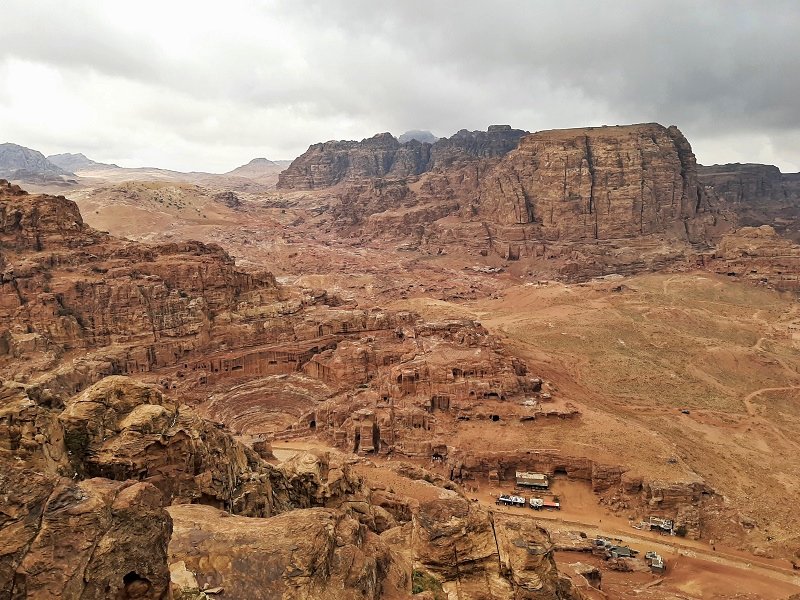

High Place of Sacrifice and the Garden Temple
The High Place of Sacrifice and the Garden Temple are two other famous sights that require a hike away from the central area of Petra.
The great aspect of this hike is that it’s a loop, allowing you to start on the Street of Façades near the theatre, climb to the High Place of Sacrifice, and descend the mountain at the other side, hiking via the Garden Temple to the end of the trail near the Great Temple and Qasr al-Bint, all without retracing your steps.
Both the sights and the views over Petra along this trail are absolutely stunning.
This Petra hike takes a minimum of two hours from its start point on the Street of Façades to its finishing point near the Great Temple, including time to admire the High Place of Sacrifice and Garden Temple.
I’ll also provide more information about this hike, as well as the High Place of Sacrifice and Garden Temple, in a separate article soon.

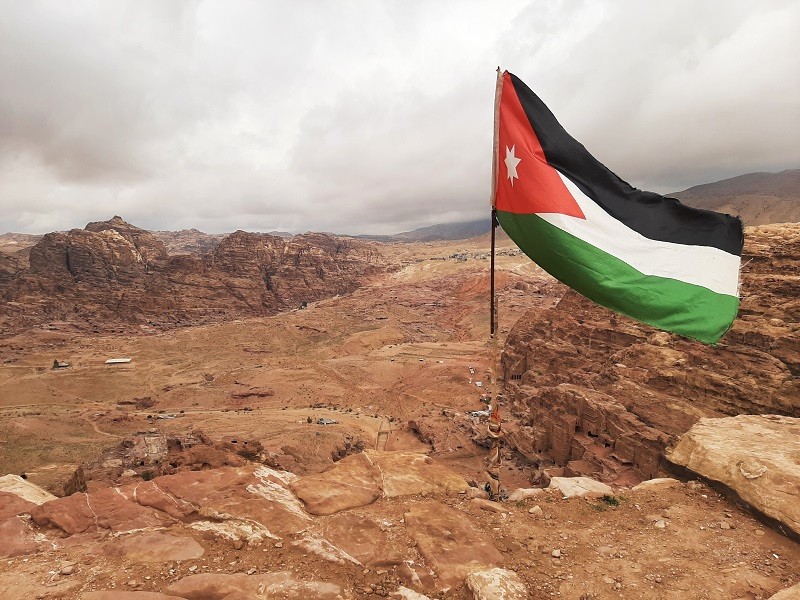

Petra: Food and drinks
When you visit, it’s highly recommended that you bring plenty of water, as well as some snacks, with you.
Visiting Petra involves a lot of walking, or even more intensive hiking into the mountains if you choose to follow one of the many trails, so it’s important to ensure you have enough energy and stay hydrated, particularly in spring, summer, or autumn when the sun can be scorching.
There are numerous souvenir stalls and small shops around Petra where you can buy basic snacks, bottled water, cans of soda, or even enjoy some freshly brewed tea or coffee, so be sure to bring some Jordanian dinar cash with you.
There are also two restaurants inside Petra, the Basin Restaurant and the Nabatean Tent Restaurant, both near the Qasr al-Bint.
Both restaurants offer a buffet-style lunch, with reports and reviews of their quality varying, so it’s probably best to view them as places to refuel rather than as the highlight of your culinary experience in Jordan (although I haven’t visited them personally!).
Outside the Petra entrance gates in the town of Wadi Musa, you’ll find plenty of places to eat, ranging from restaurants attached to the many hotels to more casual eateries offering quick falafel and kebab.
For a drink, nothing beats the Cave Bar next to the Petra Guest House Hotel, just outside the Petra entrance gates, as it’s undoubtedly the most unique venue in town for a beer or glass of wine.

Other useful information for your Petra visit
If you need to go to the toilet during your visit to Petra, you can find public toilet facilities at the Visitor Center, near the theatre, in a cave along the Street of Facades next to the steps leading up to the Royal Tombs, and close to the restaurants near Qasr al-Bint.
Apart from bringing plenty of water, you should also take sunscreen and a hat to protect yourself from the sun when visiting Petra.
Likewise, when visiting Petra between late autumn and early spring, it’s wise to bring a jacket and even a sweater, as it can get surprisingly cold when the weather is cloudy.
Indeed, on the second day of my visit to Petra in mid-March, it was even snowing lightly, and I really wished I had brought something warmer than just my spring jacket!
As it was still warm and sunny on my first day in Petra, it just shows how quickly the weather can change during the winter months in the desert.
Throughout Petra, you may encounter locals offering paid donkey rides, although it’s best to avoid using this service, as the animals are often poorly treated and not built to carry the weight of the average human, which makes it rather cruel for them.
When you walk between the Petra entrance gates and the Siq, you may encounter locals offering free horse rides.
Although the offer of a free horse ride is legitimate, the handlers do expect a tip of at least 5 Jordanian dinar (€6.20).
Not all horses are treated equally well, so it’s important to check whether the horse is in good condition and decide if it’s worth it for you, as the ride is usually very short (at most until the start of the Siq, as they are not allowed to go beyond).
Petra by Night
Petra also hosts a light show called Petra by Night, where the Treasury and Siq are beautifully illuminated by hundreds of candles.
If you want to see Petra by Night, note that the event takes place only on Mondays, Wednesdays, and Thursdays, with entry starting at 20:30 from the Visitor Center, and the guide bringing everyone back by around 22:30.
You need a separate ticket for Petra by Night, in addition to your regular daytime entry ticket, which costs 17 Jordanian dinar (€21) per person, with children under 10 free of charge.
It’s not possible to reserve Petra by Night in advance, so simply buy your ticket at the Visitor Center upon arrival.

Petra Museum
In a striking modern building located between the Visitor Center and the main car park, you’ll find the Petra Museum, which is well worth a visit.
Inside this museum, you’ll find a wealth of stunning archaeological artefacts excavated around Petra, along with all the historical information you could ever want to know about the Nabataeans and their culture.
The Petra Museum, which is free to visit, is open daily from 08:30 to 20:30 from April to October, and from 08:30 to 19:30 from November to March.


Conclusion
Petra is not only the most amazing sight in all of Jordan, but also ranks among the most impressive archaeological sites in the entire world.
Nothing prepares you for the moment when you walk through the narrow gorge of the Siq, flanked by impressive red sandstone cliffs, and catch your first glimpse of Petra’s iconic Treasury, almost appearing like a mirage in the desert.
Although many visitors to Petra focus on the main sights, such as the Siq, Treasury, and Royal Tombs, there is much more to discover across this vast archaeological site, and you really need at least two days to do it justice.
If you’re in relatively good shape, it’s a must to hike some of the trails across Petra to the outlying sights, such as the steps leading up to Ad-Dayr (The Monastery), the Al-Khubtha Trail to the scenic viewpoint high above the Treasury, or the beautiful hike to the High Place of Sacrifice and Garden Temple.
This Petra guide provides all the information you need to prepare for your visit, including historical details about the main sights, the most popular hiking trails, and practical information on ticket prices and opening hours.
However, don’t hesitate to venture off the beaten path and explore spontaneously, as Petra offers countless rock-cut tombs, temples, and scenic trails, and it’s that sense of adventure — like you’re Indiana Jones — that makes a visit so unforgettable.
Trip report index
This article is part of the ‘Journey Across Jordan: From Aqaba to Petra and Amman‘ trip report, which consists of the following chapters:
1. Subsidised Flights: Why Airline Tickets to Jordan Are So Cheap
2. The Jordan Pass: Save Money and Time on Your Jordan Trip
3. Exploring Aqaba, Jordan’s Seaside Resort City
4. Jordan Bus Travel: Amman, Aqaba, Petra, Wadi Rum by JETT Bus
5. Wadi Rum Desert: Horse Riding in Lawrence of Arabia’s Footsteps
6. Petra: How to Plan Your Visit to Jordan’s Most Famous Sight (current chapter)
** rest of the chapters to follow soon **


